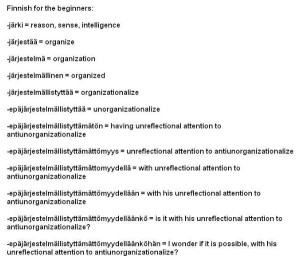Honorificabilitudinatatibus: that’s a nice long Shakespearean word to start your morning. Hope you’ve had your coffee!
Shakespeare used it only once in his entire body of work. To use a word only once in your entire body of work is called a Hapax Legomenon. These are remarkably important words for people (and I admit I am used to be of them) who count and rank words for a living.
A few more awesome examples:
The longest hapax ever to appear in literature: Lopadotemachoselachogaleokranioleipsanodrimhypotrimmatosilphioparaomelitokatakechymenokichlepikossyphophattoperisteralektryonoptekephalliokigklopeleiolagoiosiraiobaphetraganopterygon. It was invented by Aristophanes in his play “Assemblywomen” and translates to “oysters-saltfish-skate-sharks’-heads-left-over-vinegar-dressing-laserpitium-leek-with-honey-sauce-thrush-blackbird-pigeon-dove-roast-cock’s-brains-wagtail-cushat-hare-stewed-in-new-wine-gristle-of-veal-pullet’s-wings”. So, basically, stew.
“Gevinah” – another hapax legomenon. It appears only once in the Hebrew Bible (Job 10:10) and means cheese.
Another hapax: Shakespeare used the word Satyr only once. Considering he wrote Midsummer Night’s Dream, this is quite an accomplishment.

The New Testament has 686 hapax words. Over 110 of them were in either 1 or 2 Peter (roughly 8 pages of reading). Not too bad for a guy who was a Judean fisherman from Galilee.
A few of these only-once-in-the-New-Testament words: Fishhook, demon, sea monster, beryl, virginity, foam, to rub.
Why all the pedantry about “only” words?
The first rule about hapax legomenon is you don’t use the phrase hapax legomenon.
I dunno. I woke up with the phrase in my head. Now I’m blogging. I guess you’re stuck with me writing about it 🙂
At one point I considered writing a sci fi story about a society of monks who could use a word once, and only once, and never say that word again without paying a horrible price. The longer you had been in the monk’s order, the less likely you were to utter useless words. It kept them very, very quiet.
I even thought about pledging myself to the cause, in order to rein in my tongue. It never got past the thinking stage. It would also be difficult to function at work.
We are constantly being judged by the words we use. People think the scarcity of the words you use prove your intelligence. Now, listen people, I know lots and lots of words. Some of them are even long. A few of them are unique. I even made a few up.
Using unique words does NOT make you smarter. When I was 2 years old, I made up the word “dunt”. Also, “popo.” I won’t bore you with the definitions because I was two. But they were important to me at the time. After all these years, “dunt” is still kind of fun to say.

Hemingway said of a fellow writer: “Poor Faulkner. Does he really think big emotions come from big words? He thinks I don’t know the ten-dollar words. I know them all right. But there are older and simpler and better words, and those are the ones I use.”
Faulkner retorted: “[Hemingway] has never been known to use a word that might send a reader to the dictionary.”
But Abraham Lincoln, as usual, said it best: He can compress the most words into the smallest idea of any man I know.
So, where do I fall on this scale? I write down what feels right at the time. I try to be accessible. I sometimes even throw in a big word or two, not to be snooty, but because it’s who I am.
New words pop up when humans don’t have sufficient ones to describe an object or a state they’re encountering. I’m a writer (or want to be when I grow up). A primary quality of a writer is to observe and record things. Often those things are absurd, unique, or maybe terrifying. In any case, you need new words to describe new things. That’s what I aim to do. Sometimes you just need the right word to fit the right idea. Sometimes, that word is even hapax legomenon.
I love learning new words, as I have a literary blog myself, and I love this one! Great post!
LikeLike
Thanks for the comment!
LikeLike
You probably know this, but 2 Peter was almost certainly not from Peter, as folks going as far back as Calvin recognized. And the basic argument – I’m not sure whether I buy it or not – that 1 Peter wasn’t by Peter either is basically because it’s too well written.
The writer most likely to send me to a dictionary: David Bentley Hart. A more-or-less random example: “But in Gregory’s thought becoming requires no probation by nothingness, no sacrificial economy of contradiction and sublation: movement within what is, within the good, is eternal, because negation is neither the necessary condition of difference nor the source of its fecundity; difference can be forever remodulated as difference through the interminable analogical interrelatedness of finite existence because God’s plenitude of determinacy is both truly transcendent of the ontic play of this and not this, and truly Trinity.”
LikeLike
Ken, Remember the t-shirt you had, the back of which mentioned lemmings? Well, your quote from D.B. Hart makes me think of the advice written on the front of that t-shirt.
Having been illumined by life with Christ and the indwelling Holy Spirit at Pentecost, it’s very likely that the oratory and literary skills of the Apostles improved as they left off catching fishy fish and became fishers of men. St. Peter’s signature, his eyewitness account of the Transfiguration (1:16-18), and thematic unity of the two letters are points in favor of Simon Peter as the eponymous author of the second letter. Also, the tradition of the ancient church attributed both epistles to St. Peter in the centuries before they were canonized. That being said, the canonicity of 2 Peter has been challenged more than any of the 27 other books of the New Testament.
I’m not sure who makes me tap into my OED app more, Christos Yannaras or H.L.A. Hart. Both authors cause me to reread paragraphs and frequently flip back and restart whole chapters.
LikeLike
The front of the shirt said “Eschew Obfuscation” and the back “10,000 Lemmings Can’t Be Wrong.” Or maybe vice versa. Since they were structurally independent clauses, they were separated by a semicolon (Half of Ken’s colon to be exact, and maybe some ribs and viscera); since they were semantically independent clauses, I always thought they should be on separate tee shirts, because for years I had trouble figuring out the relationship between the lemmings and not using big words. Have lemmings got vocabulary problems AND a suicide wish?
LikeLike